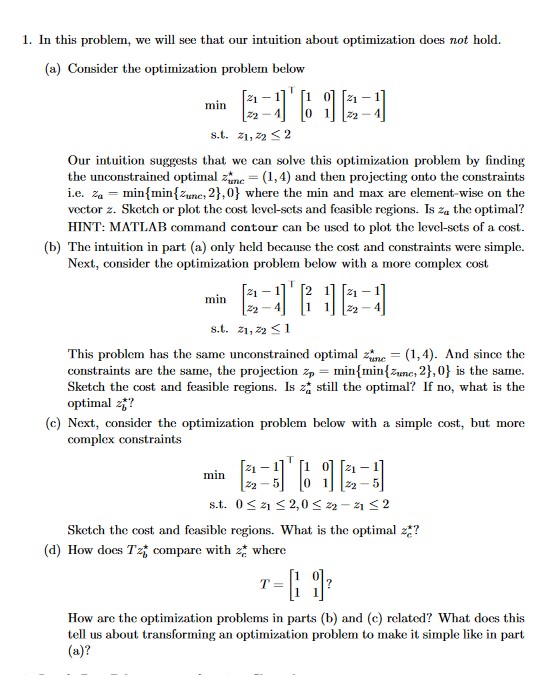Answered step by step
Verified Expert Solution
Question
1 Approved Answer
1. In this problem, we will see that our intuition about optimization does not hold. (a) Consider the optimization problem below min[z11z24][1001][z11z24]s.t.z1,z22 Our intuition suggests
 1. In this problem, we will see that our intuition about optimization does not hold. (a) Consider the optimization problem below min[z11z24][1001][z11z24]s.t.z1,z22 Our intuition suggests that we can solve this optimization problem by finding the unconstrained optimal zunc=(1,4) and then projecting onto the constraints i.e. za=min{min{zunc,2},0} where the min and max are element-wise on the vector z. Sketch or plot the cost level-sets and feasible regions. Is za the optimal? HINT: MATL B command contour can be used to plot the level-sets of a cost. (b) The intuition in part (a) only held because the cost and constraints were simple. Next, consider the optimization problem below with a more complex cost min[z11z24][2111][z11z24]s.t.z1,z21 This problem has the same unconstrained optimal zunc=(1,4). And since the constraints are the same, the projection zp=min{min{zunc,2},0} is the same. Sketch the cost and feasible regions. Is za still the optimal? If no, what is the optimal zb ? (c) Next, consider the optimization problem below with a simple cost, but more complex constraints min[z11z25][1001][z11z25]s.t.0z12,0z2z12 Sketch the cost and feasible regions. What is the optimal zc ? (d) How does Tzb compare with zc where T=[1101]? How are the optimization problems in parts (b) and (c) related? What does this tell us about transforming an optimization problem to make it simple like in part (a)
1. In this problem, we will see that our intuition about optimization does not hold. (a) Consider the optimization problem below min[z11z24][1001][z11z24]s.t.z1,z22 Our intuition suggests that we can solve this optimization problem by finding the unconstrained optimal zunc=(1,4) and then projecting onto the constraints i.e. za=min{min{zunc,2},0} where the min and max are element-wise on the vector z. Sketch or plot the cost level-sets and feasible regions. Is za the optimal? HINT: MATL B command contour can be used to plot the level-sets of a cost. (b) The intuition in part (a) only held because the cost and constraints were simple. Next, consider the optimization problem below with a more complex cost min[z11z24][2111][z11z24]s.t.z1,z21 This problem has the same unconstrained optimal zunc=(1,4). And since the constraints are the same, the projection zp=min{min{zunc,2},0} is the same. Sketch the cost and feasible regions. Is za still the optimal? If no, what is the optimal zb ? (c) Next, consider the optimization problem below with a simple cost, but more complex constraints min[z11z25][1001][z11z25]s.t.0z12,0z2z12 Sketch the cost and feasible regions. What is the optimal zc ? (d) How does Tzb compare with zc where T=[1101]? How are the optimization problems in parts (b) and (c) related? What does this tell us about transforming an optimization problem to make it simple like in part (a) Step by Step Solution
There are 3 Steps involved in it
Step: 1

Get Instant Access to Expert-Tailored Solutions
See step-by-step solutions with expert insights and AI powered tools for academic success
Step: 2

Step: 3

Ace Your Homework with AI
Get the answers you need in no time with our AI-driven, step-by-step assistance
Get Started


